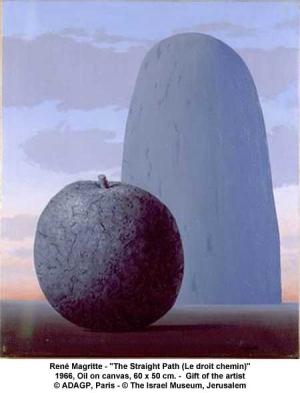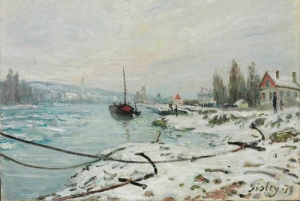|
Displaying items by tag: Pissarro
The Philadelphia Museum of Art has announced the acquisition of five major French paintings as a bequest from a longtime supporter.
The works are a late Cezanne painting of Mont Sainte-Victorie, a Manet still life of fruit, a landscape and cityscape by Pissarro and a Morisot portrait. All were a bequest from Helen Tyson Madeira, who died last year.
The museum also announced that it had received two early portraits by Marcel Duchamp.
When was the last time an expert from a top auction house dispensed with longtime allegiances and joined forces with someone from the enemy camp? In the fiercely competitive world of Sotheby’s and Christie’s, such an occurrence is rarer than a prized Vermeer.
But for months now there have been rumors that a new powerhouse partnership was in the works, one that would replace Giraud, Pissarro, Ségalot, the superprivate superdealer that pulled off so many big transactions and whose business began winding down soon after Franck Giraud, one of its partners, announced that he was leaving to “explore options inside the art world and out.”
The players making up this new venture, however, had been something of a guessing game.
In the teeth of the recession, the Ashmolean museum iin Oxford has succeeded in raising £7.83m in less than eight months, through lottery grants and more than a thousand donations from members of the public, to buy a major work by the 19th century French painter Edouard Manet which would otherwise have left the country.
The Portrait of Madame Claus, a study for one of his most famous paintings, Le Balcon, regarded as a key work in the development of Impressionist art, was sold last year for £28.5m, after being in a private collection in England since it was bought from the artist's studio in 1884. The comparative bargain price the museum paid represents the tax breaks for works of art going to national collections.

The Israel Museum will put up for sale 38 rare artworks, with an estimated value of $17 million. The museum plans to use the proceeds to upgrade its collection. Sotheby's will sell the artworks in a series of auctions, beginning on November 2, 2011, in New York, and ending in February 2012 in London.
The art up for sale includes "Le droit chemin" oil by surrealist Rene Magritte, estimated at $2.5-3.5 million; works by Camille Pissarro and Marc Chagall, estimated at $1.5-2.5 million per painting; and works by Chaïm Soutine, Pablo Picasso, and other important artists.
This is an extraordinary event that will likely echo through the international market. Museums rarely sell pieces from their collections. The Israel Museum's decision highlights the difficulties in improving their collections through donations and acquisitions budgets. Reasons for this situation include the economic crisis since 2008, which has caused donors to reduce large donations to the arts. Even before the crisis, especially in the preceding decade, soaring prices for top works of art made it difficult for museums to buy works of art.
The Israel Museum has set up an acquisitions team to help it create an organized system of acquisitions, but the process is quite complicated. Sometimes, there is competition for newly recognized important works art, and not just for already valuable pieces. Museums, which always have budget constraints, are struggling. For example, reports claim that New York's MOMA has bought the important piece "The Clock" by Christian Marclay, currently on display at the Israel Museum in its first display in a leading museum.

The Philadelphia Museum of Art has acquired three important French Impressionist paintings by Claude Monet, Camille Pissarro, and Alfred Sisley, and a pastel by Mary Cassatt, the Pennsylvania native and American expatriate who became famously associated with Paris during the late 19th century. All of the works are gifts from Chara C. and the late John Haas, longtime supporters of the Museum. They include Path on the Island of Saint Martin, Vétheuil (1881) by Claude Monet (French, 1840-1926); Apple Tree in the Meadow, Éragny (1893) by Camille Pissaro (French, 1830-1903); Mooring Lines, the Effect of Snow at Saint Cloud (1879) by Alfred Sisley (French, 1839-1899); and Madame Bérard’s Baby in a Striped Armchair (1880-81) by Mary Cassatt (American, 1844-1926). The Monet and the Pissarro have now been placed on view in gallery 152, while the Sisley hangs in gallery 157 and Cassatt’s pastel can be seen in gallery 162.
“With these remarkable gifts, John and Chara Haas have greatly enriched the Museum’s collections,” said Timothy Rub, The George D. Widener Director and CEO, “adding strength to the Museum’s extensive holdings of Impressionist art and enabling us to present a more complete picture of these artists’ remarkable achievements. We are deeply grateful to John and Chara Haas, who now join the many great collectors whose gifts have made the Philadelphia Museum of Art a major destination for art enthusiasts from around the world.”
“We are delighted to have these four works, which expand and enhance our rich Impressionist holdings with a radiant landscape by Monet created during the years he spent in Vétheuil in the late 1870s and early 1880s, a period that has not been represented in our collection, a remarkably fresh and beautifully painted winter scene by Sisley, a handsome landscape that Pissarro painted at his home in Éragny, and a charming pastel portrait of the young Lucie Bérard by Mary Cassatt,” said Joseph Rishel, The Gisela and Dennis Alter Senior Curator of European Painting before 1900, and Senior Curator of the John G. Johnson Collection and the Rodin Museum.
Monet’s Path on the Island of Saint Martin, Vétheuil (1881)is a colorful view of the fields near the village of Vétheuil on the north bank of the Seine, where Monet moved with his family in 1879. During the summer of 1881, Monet painted lush views of the town from the island of Saint Martin as his pictorial style evolved from the blunt, broad strokes of the 1870s to the delicate, rhythmic brushwork of Path on the Island of Saint Martin. This is the first work from Monet’s Vétheuil period to come into the Museum’s collection, and its presence will enable visitors to understand the development of the artist’s work during this important time in his career.
Apple Tree in the Meadow, Éragny (1893) captures the fields and gardens around Camille Pissarro’s (French, 1830-1903) home in Éragny, a small village about 90 miles northwest of Paris. This focused study joins four other views of the Pissarro home in the Museum’s collection from earlier years. A view of the meadow adjacent to Pissarro’s house (the brick building visible on the left), it is marked by the strongly-patterned brush and palette knife work common in the artist’s paintings of the 1890s and clearly demonstrates the influence that the work of the Post-Impressionist painter Georges Seurat (French, 1859-1891) had on Pissarro’s work during this period.
Alfred Sisley, an Impressionist landscape painter well represented in the Museum’s collection, painted Mooring Lines, the Effect of Snow at Saint Cloud (1879) while living to the west of Paris. Of particular note is Sisley’s dramatic treatment of the winter view in which the snowy river bank is animated by the mooring lines that secure an unseen barge to the bank of the river. Sisley was widely admired for his skillful renderings of winter scenes. Here the sky and the fugitive effects of light and weather are depicted here in nuanced tones of white and blue.
Mary Cassatt achieved remarkable success as a woman working in a field almost entirely dominated by men. Several of her sensitive portraits depicting family scenes and her nieces and nephews are in the collection at the Museum, including Portrait of Alexander J. Cassatt and His Son, Robert Kelso Cassatt (1884) and A Woman and a Girl Driving (1881). Madame Bérard’s Baby in a Striped Armchair, a portrait of 9-month-old Lucie seated on a vibrant blue striped chair, demonstrates the artist’s mastery of the pastel medium by the early 1880s. The brilliant use of red and blue in the background offsets the child, who is dressed in a formal white gown. Cassatt’s assured and sensitive handling of her young subject is particularly apparent in the modeling of Lucie’s moving hands.
|
|
|
|
|